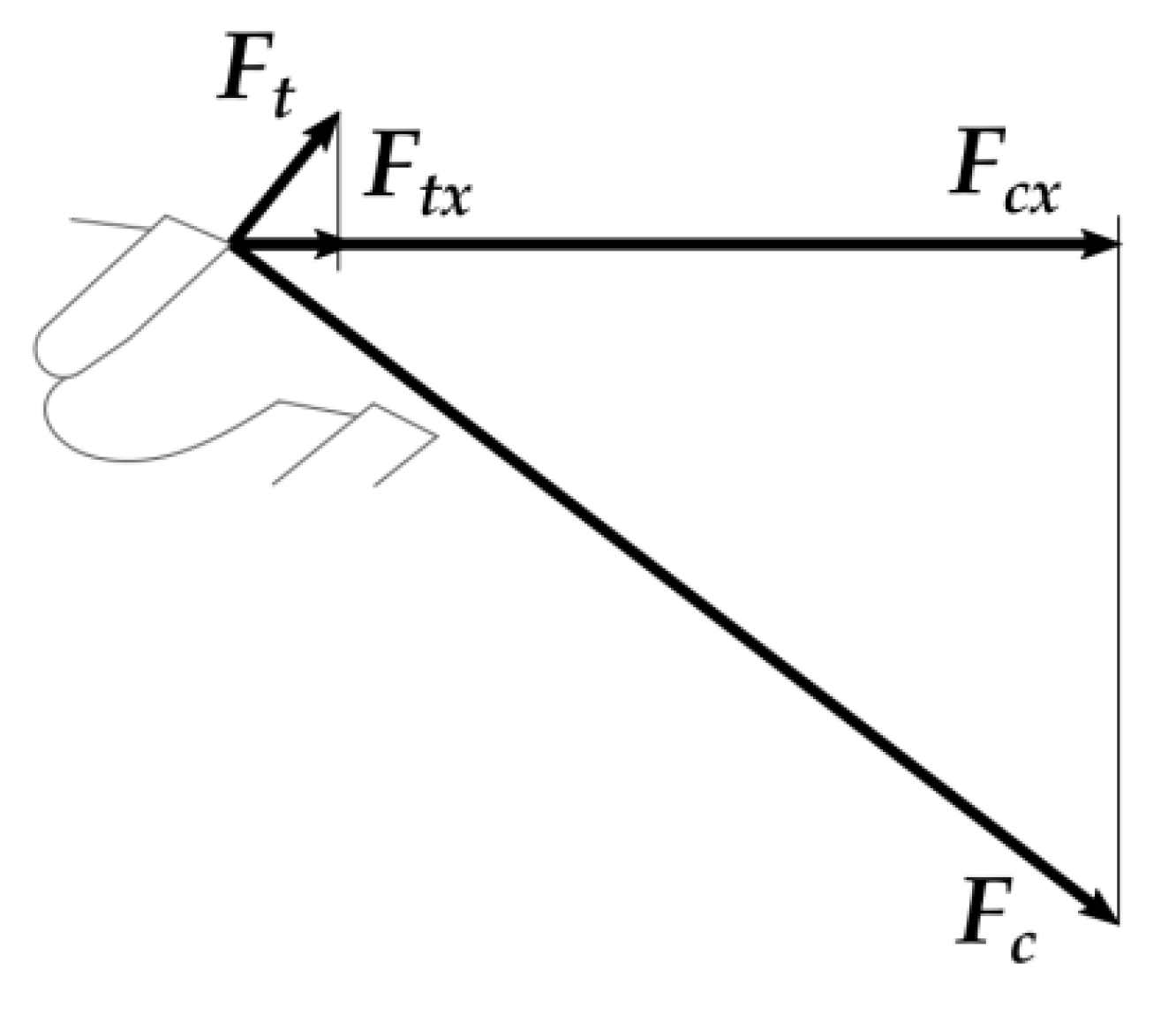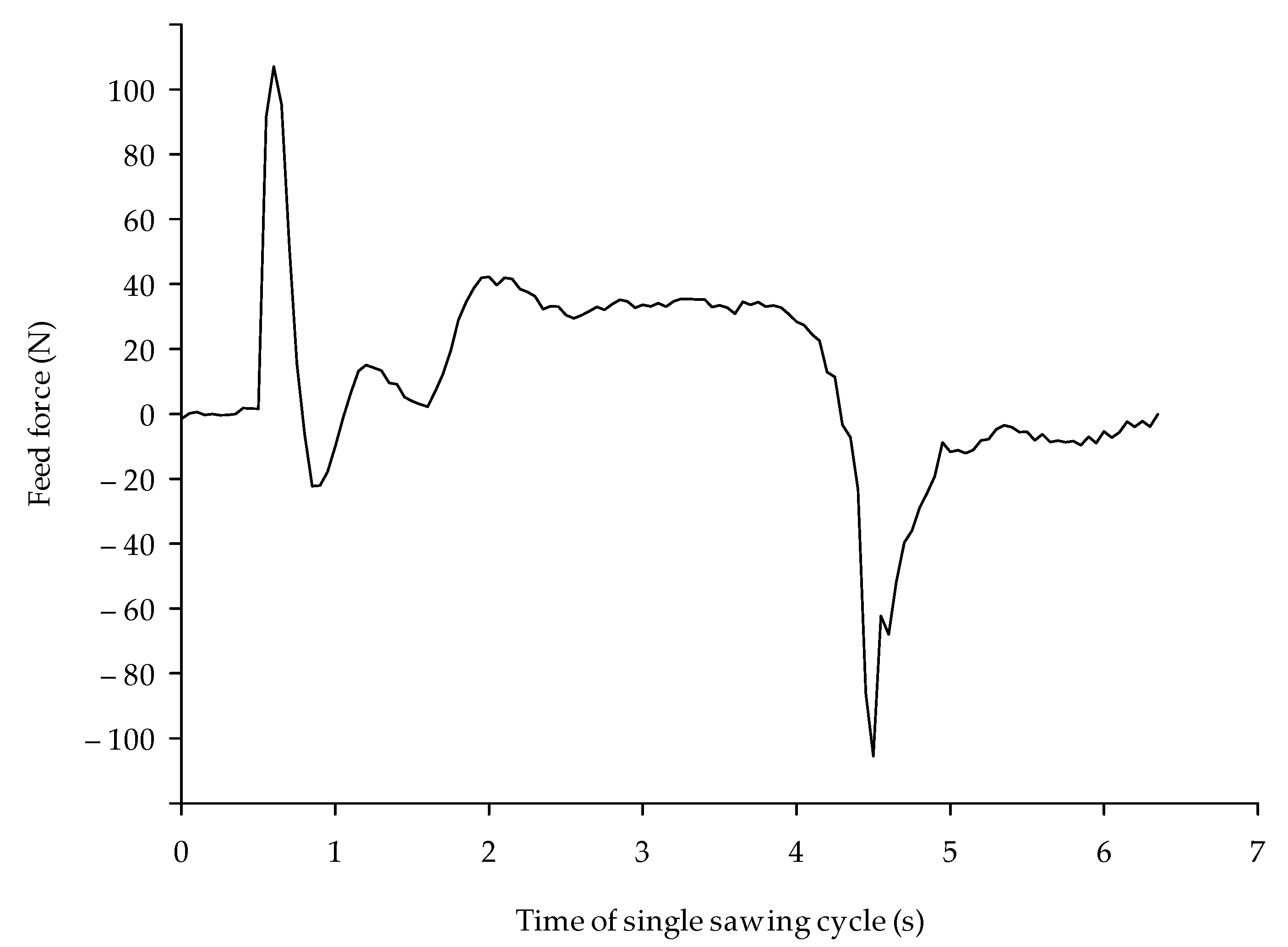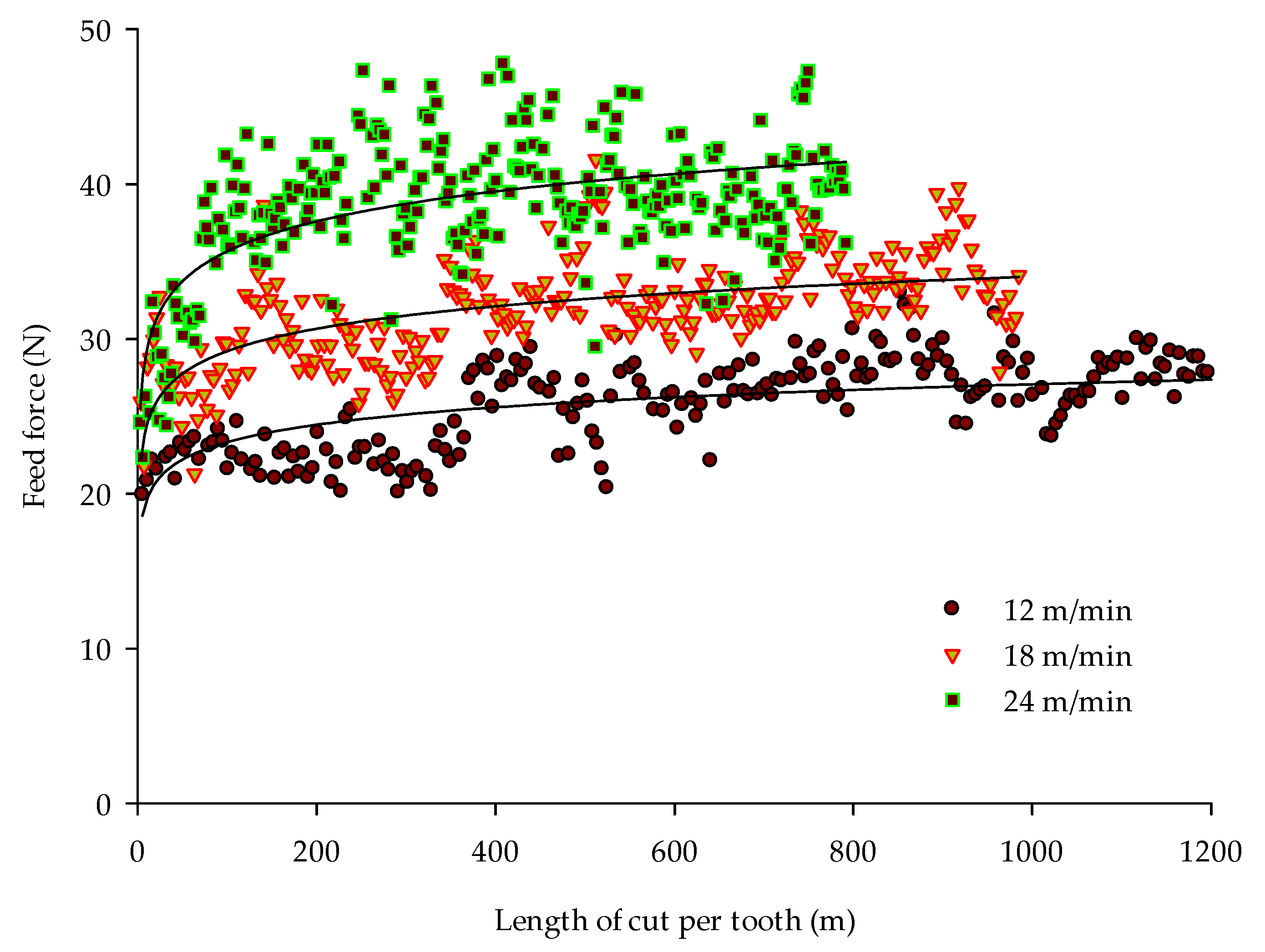Feed Force and Sawdust Geometry in Particleboard Sawing
Abstract
1. Introduction
2. Materials and Methods
- xi—mean value of particle size in i-class [μm],
- q3i—particle distribution by mass [%].
3. Results and Discussion
4. Conclusions
Author Contributions
Funding
Institutional Review Board Statement
Informed Consent Statement
Data Availability Statement
Conflicts of Interest
References
- Marchal, R.; Mothe, F.; Denaud, L.-E.; Thibaut, B.; Bleron, L. Cutting forces in wood machining—Basics and applications in industrial processes. A review COST Action E35 2004–2008: Wood machining—micromechanics and fracture. Holzforschung 2009, 63, 157–167. [Google Scholar] [CrossRef]
- Thibaut, B.; Denaud, L.; Collet, R.; Marchal, R.; Beauchêne, J.; Mothe, F.; Méausoone, P.-J.; Martin, P.; Larricq, P.; Eyma, F. Wood machining with a focus on French research in the last 50 years. Ann. For. Sci. 2016, 73, 163–184. [Google Scholar] [CrossRef]
- Kivimaa, E. Cutting Force in Woodworking (Publ. no. 18); State Institute for Technical Research: Helsinki, Finland, 1950. [Google Scholar]
- Wang, J.; Cao, P.; Guo, X.; Hong, X.; Jia, G.; Wang, B. Effect of Process Parameters on Cutting Forces and Surface Roughness during Peripheral Up Milling of Bamboo Scrimber. BioResources 2015, 10, 8414–8425. [Google Scholar] [CrossRef]
- Cristóvão, L.; Broman, O.; Grönlund, A.; Ekevad, M.; Sitoe, R. Main cutting force models for two species of tropical wood. Wood Mater. Sci. Eng. 2012, 7, 143–149. [Google Scholar] [CrossRef]
- Axelsson, B.O.M.; Grundberg, S.A.; Grönlund, J.A. The use of gray scale images when evaluating disturbances in cutting force due to changes in wood structure and tool shape. Holz Als Roh Werkst. 1991, 49, 491–494. [Google Scholar] [CrossRef]
- Loehnertz, S.P.; Cooz, I.V. Sawtooth Forces in Cutting Tropical Hardwoods Native to South America; Research paper FPL; RP-567, US Department of Agriculture, Forest Service, Forest Products Laboratory: Madison, WI, USA, 1998; pp. 1–16. [Google Scholar]
- Moradpour, P.; Scholz, F.; Doosthoseini, K.; Tarmian, A. Measurement of Wood Cutting Forces during Bandsawing Using Piezoelectric Dynamometer. Drv. Ind. 2016, 67, 79–84. [Google Scholar] [CrossRef]
- Beljo-Lučić, R.; Goglia, V.; Pervan, S.; Đukić, I.; Risović, S. The influence of wood moisture content on the process of circular rip-sawing. Part I: Power requirements and specific cutting forces. Wood Res. Bratisl. 2004, 49, 41–49. [Google Scholar]
- Heisel, U.; Martynenko, S.; Schneider, M. Influence of Chip Space Filling on Cutting Forces in High-Speed Milling of Wood and Derived Timber Products; Presses Polytechniques et Universitaires Romandes: Lausanne, Switzerland, 2007; pp. 51–54. [Google Scholar]
- Koch, P. Wood Machining Processes; Ronald Press: New York, NY, USA, 1964. [Google Scholar]
- Kminiak, R.; Kubš, J. Cutting power during cross-cutting of selected wood species with a circular saw. BioResources 2016, 11, 10528–10539. [Google Scholar] [CrossRef]
- Kminiak, R.; Orlowski, K.A.; Dzurenda, L.; Chuchala, D.; Banski, A. Effect of Thermal Treatment of Birch Wood by Saturated Water Vapor on Granulometric Composition of Chips from Sawing and Milling Processes from the Point of View of Its Processing to Composites. Appl. Sci. 2020, 10, 7545. [Google Scholar] [CrossRef]
- Dippon, J.; Ren, H.; Amara, F.B.; Altintas, Y. Orthogonal cutting mechanics of medium density fiberboards. For. Prod. J. 2000, 50, 25–30. [Google Scholar]
- Zhu, Z.; Buck, D.; Guo, X.; Ekevad, M.; Cao, P.; Wu, Z. Machinability investigation in turning of high density fiberboard. PLoS ONE 2018, 13, e0203838. [Google Scholar] [CrossRef] [PubMed]
- Kowaluk, G.; Dziurka, D.; Beer, P.; Sinn, G.; Stanzl-Tschegg, S. Influence of ammonia addition on particleboard properties. In Proceedings of the 2nd International Symposium on Wood Machining, Vienna, Austria, 5–7 July 2004; Stanzl-Tschegg, S.M., Gindl, G.S., Eds.; BOKU, Department of Material Sciences and Process Engineering: Wien, Austria, 2004; pp. 459–465. [Google Scholar]
- Liska, J. Effect of Rapid Loading on the Compressive and Flexural Strength of Wood; United States Forest Products Laboratory: Madison, WI, USA, 1950. [Google Scholar]
- Woodson, G.E. Tool Forces and Chip Formation in Orthogonal Cutting of Loblolly Pine; Southern Forest Experiment Station, Forest Service, US Department of Agriculture: Madison, WI, US, 1970; Volume 52. [Google Scholar]
- McKenzie, W.M.; Karpovich, H. Wear and blunting of the tool corner in cutting a wood-based material. Wood Sci. Technol. 1975, 9, 59–73. [Google Scholar] [CrossRef]
- Komatsu, M. Machine boring properties of wood, 2: The effects of boring conditions on the cutting forces and the accuracy of finishing. J. Jpn. Wood Res. Soc. 1976, 22, 491–497. [Google Scholar]
- Stewart, H. Optimum rake angle related to selected strength properties of wood. For. Prod. J. 1977, 27, 51–53. [Google Scholar]
- Axelsson, B.O.M.; Lundberg, Å.S.; Grönlund, J.A. Studies of the main cutting force at and near a cutting edge. Holz Als Roh- Werkst. 1993, 51, 43–48. [Google Scholar] [CrossRef]
- Ko, T.J.; Kim, H.S. Mechanistic cutting force model in band sawing. Int. J. Mach. Tools Manuf. 1999, 39, 1185–1197. [Google Scholar] [CrossRef]
- Palmqvist, J. Parallel and normal cutting forces in peripheral milling of wood. Holz Als Roh Werkst. 2003, 61, 409–415. [Google Scholar] [CrossRef]
- Goli, G.; Marchal, R.; Uzielli, L.; Negri, M. Measuring cutting forces in routing wood at various grain angles. Study and comparison between up and down-milling techniques, processing Douglas fir and oak. In Proceedings of the 16th International Wood Machining Seminar, Matsue, Japan, 24–30 August 2003; 2003; pp. 127–137. [Google Scholar]
- Boucher, J.; Méausoone, P.-J.; Perrin, L. Effects of diamond tool edge direction angle on cutting forces and tool wear during milling of medium density fibreboard and particleboard; BOKU Vienna: Wien, Austria, 2004; pp. 399–407. [Google Scholar]
- Heisel, U.; Tröger, J.; Martynenko, S. Aspects of High-Performance Cutting with Machining Centres; BOKU Vienna: Wien, Austria, 2004; pp. 161–173. [Google Scholar]
- Sinn, G.; Beer, P.; Gindl, M.; Patsch, R.; Kisselbach, A.; Standler, F.; Stanzl-Tschegg, S. Analysis of cutting forces in circumferential flat milling of MDF and particleboard. In Proceedings of the 17th IWMS, Florence, Italy, 26–28 September 2005; pp. 80–87. [Google Scholar]
- Orlowski, K.A.; Palubicki, B. Recent progress in research on the cutting processes of wood. A review COST Action E35 2004–2008: Wood machining—micromechanics and fracture. Holzforschung 2009, 63, 181–185. [Google Scholar] [CrossRef]
- Taşcıoğlu, Y.; Jackson, M.R. Material removal aspects and cutting power requirement of profile independent wood-moulding. Wood Res. 2010, 55, 131–148. [Google Scholar]
- Naylor, A.; Hackney, P. A Review of Wood Machining Literature with a Special Focus on Sawing. BioResources 2013, 8, 3122–3135. [Google Scholar] [CrossRef]
- Guo, X.; Ekevad, M.; Marklund, B.; Li, R.; Cao, P.; Grönlund, A. Cutting Forces and Chip Morphology during Wood Plastic Composites Orthogonal Cutting. BioResources 2014, 9, 2090–2106. [Google Scholar] [CrossRef]
- Krenke, T.; Frybort, S.; Müller, U. Determining cutting force parameters by applying a system function. Mach. Sci. Technol. 2017, 21, 436–451. [Google Scholar] [CrossRef]
- Hlásková, L.; Kopecký, Z.; Solař, A.; Patočka, Z. Cutting test as source of fracture toughness and shear yield strength for axial-perpendicular model of wood cutting. Wood Fiber Sci. 2019, 51, 58–68. [Google Scholar] [CrossRef]
- Kos, A.; Beljo-Lučić, R.; Šega, K.; Rapp, A.O. Influence of woodworking machine cutting parameters on the surrounding air dustiness. Holz Als Roh Werkst. 2004, 62, 169–176. [Google Scholar] [CrossRef]
- Fujimoto, K.; Takano, T.; Okumura, S. Difference in mass concentration of airborne dust during circular sawing of five wood-based materials. J. Wood Sci. 2011, 57, 149–154. [Google Scholar] [CrossRef]
- Hlásková, L.; Rogoziński, T.; Kopecký, Z. Influence of Feed Speed on the Content of Fine Dust during Cutting of Two-Side-Laminated Particleboards. Drv. Ind. 2016, 67, 9–15. [Google Scholar] [CrossRef]
- Mračková, E.; Krišťák, Ľ.; Kučerka, M.; Gaff, M.; Gajtanska, M. Creation of wood dust during wood processing: Size analysis, dust separation, and occupational health. BioResources 2016, 11, 209–222. [Google Scholar] [CrossRef]
- Očkajová, A.; Stebila, J.; Rybakowski, M.; Rogozinski, T.; Krišták, L.; L’uptáková, J. The Granularity of Dust Particles when Sanding Wood and Wood-Based Materials. Adv. Mater. Res. 2014, 1001, 432–437. [Google Scholar] [CrossRef]
- Očkajová, A.; Kučerka, M.; Banski, A.; Rogoziński, T. Factors affecting the granularity of wood dust particles. Chip Chipless Woodwork. Process. 2016, 10, 137–144. [Google Scholar]
- Očkajová, A.; Kučerka, M. Granularity of dust particles obtained in the process of sanding and milling of particleboard. Woodwork. Tech. 2011, 4, 211–217. [Google Scholar]
- Rogoziński, T.; Očkajová, A. Comparison of two methods for granularity determination of wood dust particles. Ann. Wars. Univ. Life Sci. SGGW For. Wood Technol. 2013, 81, 197–202. [Google Scholar]
- Rogoziński, T.; Wilkowski, J.; Gorski, J.; Czarniak, P.; Podziewski, P.; Szymanowski, K. Dust Creation in CNC Drilling of Wood Composites. Bioresources 2015, 10, 3657–3665. [Google Scholar] [CrossRef][Green Version]
- Rogoziński, T.; Wilkowski, J.; Górski, J.; Szymanowski, K.; Podziewski, P.; Czarniak, P. Fine particles content in dust created in CNC milling of selected wood composites. Wood Fiber Sci. 2017, 49, 461–469. [Google Scholar]
- Gottlöber, C. Zerspanung von Holz und Holzwerkstoffen: Grundlagen–Systematik–Modellierung–Prozessgestaltung; Carl Hanser Verlag GmbH Co KG: Munchen, Germany, 2014; ISBN 3-446-44003-8. [Google Scholar]
- ISO 2591-1:1998. Test Sieving—Part 1: Methods Using Test Sieves of Woven Wire Cloth and Perforated Metal Plate; ISO: Geneva, Switzerland, 1988. [Google Scholar]





| Particle Size Range [μm] | Arithmetic Mean of Particle Sizes | Mean Feed Force | ||||||
|---|---|---|---|---|---|---|---|---|
| <63 | 63–125 | 125–250 | 250–500 | 500–1000 | ≥1000 | |||
| Feed rate | 0.965 * | 0.995 ** | −0.561 | −0.979 * | −0.992 * | −0.717 | −0.987 * | 0.949 |
| Mean feed force | 0.998 ** | 0.976 * | −0.270 | −0.993 * | −0.981 * | −0.460 | −0.987 * | x |
Publisher’s Note: MDPI stays neutral with regard to jurisdictional claims in published maps and institutional affiliations. |
© 2021 by the authors. Licensee MDPI, Basel, Switzerland. This article is an open access article distributed under the terms and conditions of the Creative Commons Attribution (CC BY) license (http://creativecommons.org/licenses/by/4.0/).
Share and Cite
Pałubicki, B.; Hlásková, L.; Frömel-Frybort, S.; Rogoziński, T. Feed Force and Sawdust Geometry in Particleboard Sawing. Materials 2021, 14, 945. https://doi.org/10.3390/ma14040945
Pałubicki B, Hlásková L, Frömel-Frybort S, Rogoziński T. Feed Force and Sawdust Geometry in Particleboard Sawing. Materials. 2021; 14(4):945. https://doi.org/10.3390/ma14040945
Chicago/Turabian StylePałubicki, Bartosz, Luďka Hlásková, Stephan Frömel-Frybort, and Tomasz Rogoziński. 2021. "Feed Force and Sawdust Geometry in Particleboard Sawing" Materials 14, no. 4: 945. https://doi.org/10.3390/ma14040945
APA StylePałubicki, B., Hlásková, L., Frömel-Frybort, S., & Rogoziński, T. (2021). Feed Force and Sawdust Geometry in Particleboard Sawing. Materials, 14(4), 945. https://doi.org/10.3390/ma14040945







